Onion Maggots
Onion maggot is a common and destructive insect pest in onion-producing regions of Canada. In Manitoba, onion losses from maggot infestations have generally not been economically significant over the last decade.
Biology And Background
Pupae
The onion maggot overwinters in Manitoba soil in the pupal stage. Pupae are brown, oval and slightly larger than a grain of wheat (Figure 1). When the weather warms up in the spring, pupae develop into adults, which emerge in late May to early June.
Adult
These greyish flies can be seen in dandelions along field borders and resemble common house flies. The main difference is that the onion maggot has larger legs and a narrower abdomen. Adult flies can mate at 6 days old and eggs are laid three to four days later (Figure 2). The females, which are larger then males, have a life span of 30 days.
Eggs
During their lifetime, adult flies can lay up to 200 eggs, usually in three different batches a few days apart. Eggs are laid close to the ground at the base of the onion stalk. The eggs hatch in seven to ten days and the larvae are small, elongated and white.
Larvae
Once hatched they become the onion maggot (Figure 4) , the damaging stage. These maggots, whose bodies taper towards the front, are tiny, white and legless with dark feeding hooks on the tapered end. The larvae bore into the lower stem of the onion and feed on the bulb for 14 to 18 days. If a seedling dies before the maggot is fully grown 1/4 inch (1 cm), the maggot moves to the next closest onion. After feeding the maggot returns to the soil and pupates.
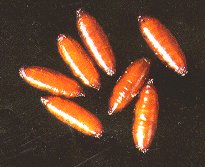
Figure 1 Pupae are brown, oval and slightly larger than a grain of wheat
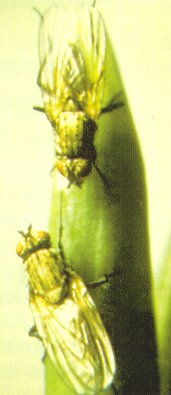
Figure 2 Adult flies can mate at 6 days old and eggs are laid three to four days later
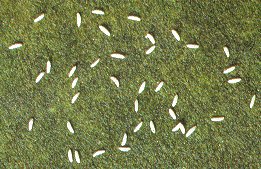
Figure 3 Onion maggots
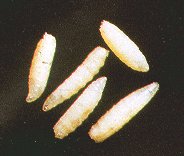
Figure 4 Onion maggots
Integrated Pest Management Of Onion Maggots
Pest Cycle
Unlike Ontario, there are only two noticeable generations of onion maggot flies in Manitoba. Adult flies emerging from pupae in late May to June are referred to as the overwintering generation. Flies that emerge in July to early August are known as the first generation. Activity of late August flies is non-existent.
Disease And Damage
The first damage can be seen mid June to early July. The main damage is caused by the maggot stage, because maggots burrow into and feed on the plant. The damaged onion will become flabby, and the leaves will appear yellow and wilted. Wilted plants, when pulled, will break below the rotting stem.
Smaller bulbs may be completely hollowed out, and larger bulbs which contain feeding cavities will rot in storage (Figure 6). The damage caused by the maggots may result in secondary rots becoming established. Although most of the damage found in Manitoba is soft rot, the contribution from maggot-created lesions is minimal. Most of the damage from onion maggots will appear in patches of dying plants, rather than single plants, since the adults lay their eggs in batches.
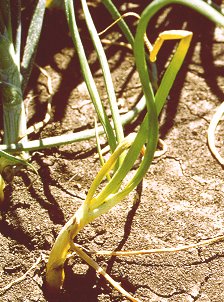
Figure 5 Maggot-damaged onion
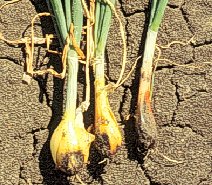
Figure 6 Onion bulbs damaged by maggots
Monitoring
In the past, growers routinely applied insecticides on a weekly basis, beginning when the onion maggot flies first appeared. This encourages resistance development, resulting in excessive use of insecticides and high costs, and often does not provide adequate control. Good control can be achieved with a few sprays (one to three) timed to hit the peak population of flies. The timing for such sprays can be based on temperature on trap catches. A combination of the two methods is preferred. The development of the maggot can be predicted by maintaining a good record of temperature. When spring temperatures rise above 4 °C, overwintering pupae begin to develop. Emergence usually begins when 250 to 300 degree-days above 4°C have accumulated.
Yellow sticky traps can be used to monitor flies. The traps, consisting of three one-litre cartons, are placed one inch (25 cm) apart. These traps are placed along the field edge above the crop canopy and should be replaced regularly. The number of traps per field varies with field size. Each trap should be checked twice weekly and counts are recorded as flies/trap/day.
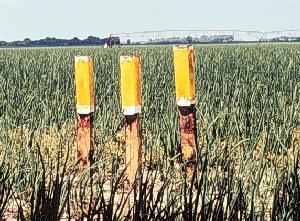
Figure 7 Yellow sticky traps
In Manitoba, Ontario thresholds [flies/tray/day (F/T/D)] have been followed to control first-generation onion maggot flies.
If overwintering generation onion damage is:
- less than two per cent. Do not spray.
- two to five per cent. A threshold of five F/T/D or more require first generation fly control.
- greater than five per cent. Thresholds of two to four F/T/D require first generation fly control.
Assessing Maggot Damage
Random sampling is used to monitor the degree of damage caused by the onion maggot.
- Plants should be assessed at the one to two leaf stage after peak levels have been seen in the field.
- Depending on field size, four to eight plots of 100 plants each should be assessed throughout the field.
It is important to distinguish between onion maggot damage and damage from other sources, such as cutworms and onion basal rot. With proper monitoring techniques and good management, onion maggots should not become an uncontrollable problem.
Management
Insecticide treatment for onion maggot control is usually done for the first generation, which is based on economic thresholds determined from the level of damage caused by the overwintering generation. The arrival of both generations is indicated by yellow sticky trap counts.
Cultural Controls
All onions and crop debris be removed from the field because these onions are feeding grounds for onion maggots. Without onion debris and culls, there is less chance of the overwintering generation surviving. Management practices such as minimizing mechanical damage, crop rotation and forecasting of life cycles are also recommended.
Chemical Controls
Granular application at planting time is the most important aspect of chemical control with insecticides. Where fly populations are high and granular treatments are not providing good control, sprays against the adults may be needed.
